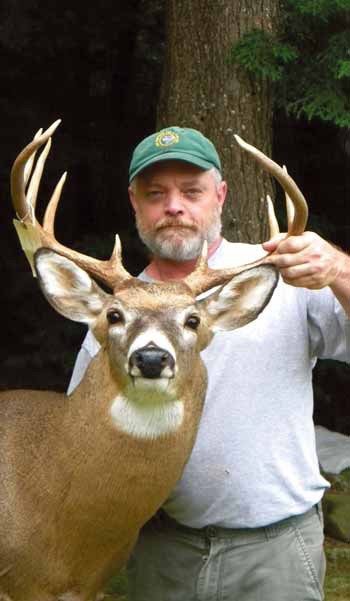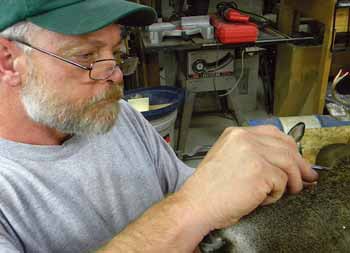In the basement of the New Hampshire Fish and Game department’s Concord office, down an industrial gray set of stairs, and through a hallway that smells like an elementary school library, a visitor comes to a nondescript door that opens into a museum-quality panoramic scene. There’s a fisher scrambling down a birch tree, a bobcat poised on a rock ledge, a vernal pool full of wood frogs, peepers, and spotted salamanders.
But it’s a pair of moose that dominate the room – a cow and a calf, frozen in mid-stride as they walk through a snow-dappled spruce thicket. They’re pretend, of course. Or half pretend – the feet, the hide, the hair are real. When the department decided that the animals might be resurrected to help educate children about the outdoors, they dropped off a pile of flesh, hide, and head at Leon Verville’s house on the outskirts of Loudon, New Hampshire, telling him, in so many words, to bring the animals back to life – in body anyway.
Those who know Verville could easily picture him shrugging his shoulders nonchalantly, moving his Harley Davidson out of the shop to make room, and getting to work.
Anyone but a mortician would find the craft of taxidermy a bit odd. You have to know biology and Bondo. You have to have an artist’s eye and a laborer’s disposition as you spend long stretches scraping gore off of green hide. Verville’s been practicing the craft for 30 years. “I was brought up around it,” he said. “Hunting and fishing was what my family did, and my uncle and some family friends were into taxidermy.”
Verville’s first piece was a squirrel that he stuffed using excelsior and twine. He carved the head himself out of foam. He was 14 at the time. “It looked like something from the Wizard of Oz when I was done with it,” he said.
Verville has since tackled some pretty exotic fare, including wolverine, African sable, mountain lion, Kodiak bear, and a Bengal tiger, among many other things. He’s done spotted whitetailed fawns, baby bear cubs, and a variety of other non-game species (he had special permits for all the non-game animals, all of which died of natural causes). The thing he’s proudest of? A life-sized musk ox. (“I was inspired by Cousin Itt,” he deadpans.) Weirdest thing? Somebody’s pet dog.
The bread and butter of any taxidermist’s business comes from sportsmen and women, and autumn is of course Verville’s busiest time.
“From September through November, Leon’s working nine days a week,” he said.
Over the course of the fall, he’ll take in a year’s worth of work – maybe 100 deer, 20 bear, 20 moose, a dozen full-body turkey mounts and 20 or so tails. In addition to regional game animals, last year he did 10 antelope, nine mule deer, three elk. There are also the occasional duck and fish, though he’s trying to get away from these species. He says it takes him 12 hours from start to finish to do a run-of-the-mill deer head. Special projects take exponentially more time. He works by himself, though his wife Linda helps with the paperwork.
The standard line you often get when you talk to workshop-in-the-backyard taxidermists is that they take the time to do things right, while the big shops that are doing volume are just churning out heads. There’s undoubtedly some truth to this, but it’s not in Verville’s personality to point this out. When asked what separates his handsome work from all the ugly taxidermy that’s out there, he shrugs his shoulders modestly and says that there are a lot of guys who do good work in the Northeast. He names several by name. “I don’t talk bad about anybody,” he says.
He’s also quick to point out that when you mount animals for a living, at some point, the art aspect and the business aspect collide. The reality on the ground is that the majority of his customers drop off a deer and a deposit check and tell him to call them when he’s done. In these cases it’s a straight business transaction. For their $500, which is a lot of money to a lot of people, they want a standard full-shoulder mount, a slight turn to the head, ears cupped forward. He’s happy to accommodate this, and says that the taxidermists on the contest circuit – who put in 20, 30, 50 hours on a mount replicating minute and exacting details – are practicing the craft differently than he is.
Still, for the occasional customer who’s willing to pay for precision detail, he’s more than happy to go above and beyond. He proudly shares snapshots of some of these projects with me – there’s one breathtaking mount of two bucks fighting with their horns locked; there’s a picture of him and Linda’s hairdresser bent in concentration over a life-sized Dall sheep mount, the hairdresser providing accents to the sheep’s coat with Lady Clairol.
Verville’s not the type who would refer to himself as an artist; you have to look closely and come to this conclusion yourself. He skins and fleshes every animal himself. “I don’t want anybody touching anything,” he says. Those familiar with hide processing will recognize the artisanship in that statement, as this seeming grunt work is more complicated than it sounds. The thin skin around an animal’s lips and eyes, hooves, or tiny toe bones has to be meticulously laid bare. The auricular cartilage structure has to be removed from the ears. “A finished mount is only as good as the skin you start with,” he says.
When clean, a hide is marked with an individual code, then shipped to a commercial tanner. When it returns, it’s rehydrated, and any tears, scars, or rubs are lanced and resewn with fishing line (30-pound test, if you were wondering).
A creamy yellow, mannequin-like form, embellished with sculpted tendons and muscles, is any mount’s foundation, but they all require a fair amount of customization. In some cases, the form itself is split and modified with knives, sandpaper, and polyurethane foam. (The calf moose in the Concord diorama is a great example of this – it’s actually a moose head on an aggressively modified elk form) In other cases, clay is used to modify the existing shape. The one interesting exception to the rule is turkeys; in their case, a mannequin forms the body but the head is freeze-dried and used in its natural state.
The form is smeared with hide paste, and the skin draped over it. If it’s a full-body mount, modeling clay is used to shape the animal’s toes, heel pads, and tendons.
With a deer shoulder mount, the finesse work goes into the neck. Skin is stretched, bonded, and wedged in a way that defines the rutting buck’s musculature and implies aggression (or, conversely, a doe’s form is softened). The deer’s ears are stripped bare, and then the inner ear is rebuilt to give a tight, natural appearance. Prefabricated eyes are chosen to accent a particular pose: different reflective properties are specially chosen to give each mount a Mona Lisa-like quality.
Then there’s the finish work: brushing the hide out; sewing each incision closed; restoring the color of the nose, eyelids, lips; rebuilding shrunken areas with wax or sculpting compounds. Full body mounts are often set on pedestals – faux rocks or logs that Verville builds himself with fiberglass and chicken wire and finishes with driftwood and floral accents.
Verville’s shop is in the basement of his home – a rustic log cabin. Among other things, he credits his organized, clean shop to Linda. “Linda’s threatened to shoot me if any stink rises,” he says jokingly, “so I won’t take anything into my shop that’s past due.”
The shop is part showroom, part workspace, and part basement. Dozens of antler racks hang in ordered rows from an unfinished ceiling and drying deer hides spill from an industrial sink. A pile of mounts in mid-completion compete for space with miter saws, metal shelving, and a water heater. One finished wall boasts some special show pieces, but the rest live upstairs, in a living room that looks like you’d figure a taxidermist’s living room might look (there’s a wild turkey flying up the west wall, for one thing.)
Verville has a serious face and kind eyes; when he talks he wastes no words. When asked if he went to taxidermy school, he replied, “No, I learned this stuff by doing it.”
How’s business? “I make a living but I’m not getting rich.”
He won’t toot his own horn, but when he poses for a picture with a finished mount he looks proud – his look says, “My work speaks for itself.”




